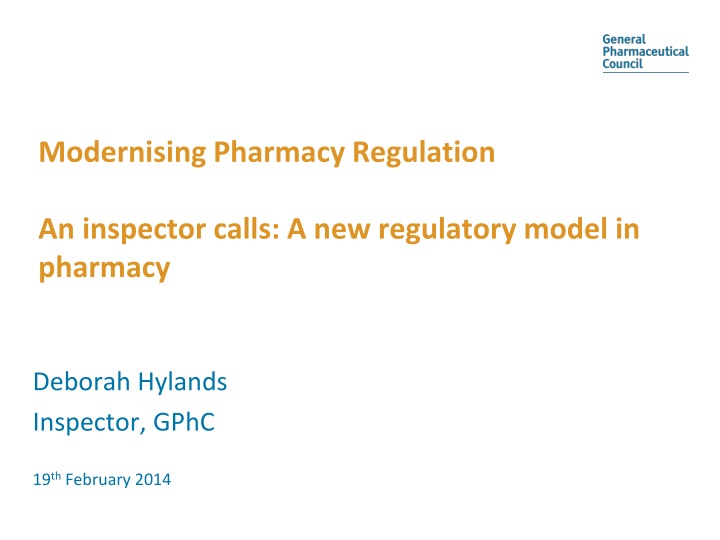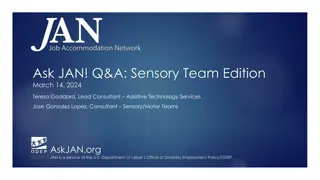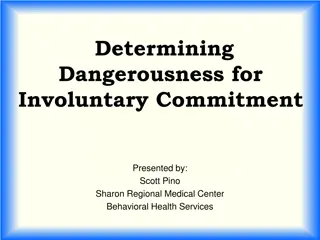
Modernising Pharmacy Regulation: Enhancing Standards and Accountability
The General Pharmaceutical Council (GPhC) plays a crucial role in safeguarding public health by ensuring that pharmacy registrants adhere to set standards. This involves approving qualifications, maintaining registers, setting conduct standards, and overseeing fitness to practice. The regulatory model focuses on individual and organizational accountability, akin to other healthcare regulatory bodies. The goal is to improve pharmacy practice quality for better health outcomes in England, Scotland, and Wales.
Download Presentation

Please find below an Image/Link to download the presentation.
The content on the website is provided AS IS for your information and personal use only. It may not be sold, licensed, or shared on other websites without obtaining consent from the author. If you encounter any issues during the download, it is possible that the publisher has removed the file from their server.
You are allowed to download the files provided on this website for personal or commercial use, subject to the condition that they are used lawfully. All files are the property of their respective owners.
The content on the website is provided AS IS for your information and personal use only. It may not be sold, licensed, or shared on other websites without obtaining consent from the author.
E N D
Presentation Transcript
Modernising Pharmacy Regulation An inspector calls: A new regulatory model in pharmacy Deborah Hylands Inspector, GPhC 19thFebruary 2014
Our statutory role To protect, promote and maintain the health, safety and wellbeing of members of the public...by ensuring that registrants, and those persons carrying on a retail pharmacy business... Adhere to such standards as the Council considers necessary...
How? Education: Approving qualifications for pharmacists and pharmacy technicians and accrediting education and training providers Registration: Maintaining the register of pharmacists, pharmacy technicians and pharmacy premises Setting standards: For conduct, ethics and performance; education and training; and continuing professional development (CPD); and standards for the safe and effective practice of pharmacy at registered pharmacies Fitness to practise: Ensuring professionals on our register are fit to practise and dealing fairly and proportionately with complaints and concerns.
About us Professional regulation System regulation Regulating pharmacy professionals through standards for conduct, ethics and performance Taking action where the fitness to practise of a registered pharmacy professional may be impaired Regulating pharmacies through standards for registered pharmacies Requiring owners and superintendents to secure compliance with those standards If the standards are not met, registration of the pharmacy is at stake Organisational accountability (through owner/superintendent) Analogous to Care Quality Commission If the standards not met, registration of that pharmacy professional at stake Individual professional accountability Analogous to GMC/NMC
Summing up our approach Council s vision is for pharmacy regulation to play its part in improving quality in pharmacy practice and ultimately health and well-being in England, Scotland and Wales
STANDARDS FOR REGISTERED PHARMACIES
Our approach to standard setting A focus on outcomes, not prescriptive rules: set out what safe and effective pharmacy practice looks like for patients Leaves it to pharmacy professionals - they are the experts - to decide how to deliver that safe and effective practice New accountability structure: being accountable for what they are responsible for which is why pharmacy owners and superintendents are accountable for meeting the new standards
So what do we mean by outcome ... An outcome is the ultimate result of something being in place or for an action being undertaken Example: Putting in a pedestrian crossing is an output People are safer crossing the road is the outcome Easier for those with mobility difficulties to get about is also the outcome
What does this mean in pharmacy? In practice, this means pharmacies should have as their top priority, patients and keeping them safe, and should be able to show how they do that, every day It will be up to pharmacies to provide the evidence and examples in whatever way they choose
Standards for registered pharmacies: Five principles Principle 1 looks at how risk is managed Principle 2 looks at how people / staff are managed Principle 3 looks at how the building / premises is managed Principle 4 is about how pharmacy services are delivered Principle 5 is about the equipment and facilities they have and use to deliver services
Meeting the standards Pharmacies should meet the standards every day not just when an inspector calls Our inspections are just one way that we assure that pharmacies are keeping patients and the public safe For instance, owners and superintendents renewing the registration of their pharmacies need to declare that they have read the standards and undertake to meet them
How will we know the standards are being met? Prototype of our approach to inspecting against the standards running from 4 November Testing four indicative judgements of performance poor, satisfactory, good and excellent Inspection outcome decision framework to aid inspectors in making consistent judgements Improvement action plans operational Pharmacy owner and superintendent will get a report, but no public reports during prototype phase Strategic relationship management has started
Inspection labels and descriptions Poor pharmacy has failed to achieve the pharmacy standards overall. There are major concerns that require immediate improvement. Good pharmacy achieves all standards consistently well and has systematic review arrangements that ensure continual improvement in the quality and safety of pharmacy services delivered to patients. Excellent pharmacy demonstrates all the hallmarks of a good pharmacy. In addition, it is either innovative and/or provides unique services that meet the health needs of the local community and that other pharmacies might learn from. Satisfactory pharmacy achieves all or the majority of standards and may require some improvement action to address minor issues.
Action learning testing what weve done New potential risks identified Quite a low level of awareness of new premises standards in general Language of governance and risk management is quite challenging On site test inspections in 3 phases Around 150 full test inspections completed 65:35 split independents to multiples Snapshot of what we found Most inspections identified a number of relatively minor issues More rigorous assessment - triangulation of evidence Action Learning Cycle
Early indicative inspection trends from testing Most common standards not met from early testing: Management of medicines & medical devices (4.3) Risk management identification & management (1.1) Records management (1.6) Risk reviewed & monitored (1.2) Pharmacy services managed & delivered safely (4.2) Premises safe, clean & properly maintained (3.1) Most common combinations of standards not met: 1.1 & 1.2 4.2 & 4.3 1.1, 1.2, 4.2 & 4.3
What feedback was received? Pharmacists value the instant feedback Positive engagement with staff team Show and tell approach welcomed Seen as a learning and development opportunity for all pharmacy team Inspector on site for longer
Resources We have a new resource with more information at http://pharmacyregulation.org/pharmacystandardsguide




















